UPDATED REVIEW – July 1, 2024 – Donner DDP-80 digital piano and DDP-80 Plus – The Donner DDP-80 digital piano model sells on-line (on Amazon) for approx $659 (sometimes it is on sale for less money) and is being promoted by the Donner company to be a digital piano substitute for a real acoustic piano. The Donner company apparently has been around for about 9 or 10 years and is manufactured in China. The Eastar company who makes similar models of digital pianos under the Eastar name, is the Chinese parent company of Donner. You will see Donner products advertised on the Eastar website. Also, as far as I can tell, they also manufacture 2 other brands of music products under different names.
THE DDP-80 CABINET
An obvious aspect of this Donner DDP-80 model is its more unusual and unique cabinet design and color. In the box it comes with the piano slab portion which has front beveled edges (a nice touch) and the 4 longer, round tapered legs which are also minimalistic in dimension and size, and they screw into the bottom of the piano on either end for support. The cabinet color does not seem to be defined by the Donner company but the color looks like, what is more commonly referred to as, Fruitwood, Bloodwood, or Light Cherry Wood, but it definitely has an orangey-brown woodgrain style to it. I would classify this cabinet style as “Boho chic” (retro) mid-century in design and color. In other words I think Donner is trying to offer this retro (50’s, 60’s) style for certain people who would gravitate towards it. That’s fine, but is it a really good digital piano for the money?
Then in a large ad image they have a main heading which says “Layer by Layer Process.” Under that heading is a sub heading which says: “Beautiful color of 5A solid wood, environmentally friendly and odorless process.” This last statement is also in that same image showing a woodworker man with overalls on who looks like he is sanding on the surface of wood furniture. In that same image Donner also has sub headings that say “Environmental Protection,” “Easy to Clean,” and “Hard & Durable.” These people are somewhat “tricky.” Notice that they use the words “color of “5A solid wood.” They do not say this piano is wood, they say it is the color of wood. It’s just advertising hype to get you to think this piano is made of real organic solid wood.
There is a big image on the Donner web site which has a photo of the DDP-80 piano in a room and the sub heading says “Luxury Wooden Appearance.” Under that subheading in that ad image is descriptive text which says: The DDP-80 comes with a light weighted body, four delicate stands and a portable 3 pedal, while the deluxe wooden texture will grace every room.” Delicate stands (legs)? Metal is not delicate and the legs are metal, not wood.
What I am trying to say is that the DDP-80 is (as far as I can tell by my personal experience and inspection), is not made of traditional wood with a wood laminate. The DDP-80 is made of of mostly MDF board with a vinyl laminate. Take a look at the bottom of the piano and you will see what I mean (photo included).
MDF board for the bulk of the interior digital cabinet sides and structure is for the strength and durability and then a veneer vinyl wrap or artificial photo-finish laminate is used on the outside of the cabinet to give it the appearance of a wood finish. The wood-grain appearance of the DDP-80 is only skin deep. Under that appearance is not actual solid wood but instead it is MDF board and that’s fine. In my opinion, Donner did a very good job in manufacturing this cabinet and overall it does look good.
They also mention in their ad that this piano has a “deluxe wooden texture.“ I don’t agree with that statement because the outside of the piano is not real wood veneer. But nonetheless, the outside imitation veneer does have some built-in texture to it so it’s a bit smooth but not totally smooth and to some people it may feel like real wood, but it is definitely not real organic wood veneer. But either way that’s OK…you are probably not going to be touching the outside of this piano too often.
Again, if you look closely at under the piano and inside of the piano you can see all the fiber-board and a very thin laminate of artificial veneer with a wood-like appearance on the outside of it. It’s the “appearance” that really counts and in that way the Donner company did a very good job at making their piano look like it is made of real wood…but it is not. Also, you can just “feel” the outside of the piano because natural wood really does not feel like that, although the simulated texture might fool you. It’s an imitation veneer and that technology is used by pretty much all of the digital piano manufacturer these days in one way or another with regard to making their digital piano cabinets.
In this case with the DDP-80 the Donner company made the outside of the piano look like it is a lighter color wood-tone and they did a good job of it. But using the words “wood or wooden” in their ads does not help them with their credibility in my opinion when they do not specifically say that it is not actual (non engineered) wood. They should just say that their piano “looks like wood” but is not real natural wood. If you want to see what this piano actually looks like, then you just go underneath the piano and in the inside of the piano. Take a look at the photos within this review and you’ll see what I am talking about.
Oh, and by the way, Donner put an imitation wrapped veneer on each of the 4 legs of the DDP-80. The legs look like they could be “wood,” but they are not wood and they are not “delicate.”. In fact they are not even engineered fiber-board wood…those legs are metal. How do I know that? It’s easy, you just tap on the legs with screwdriver or another harder object and then you can “hear” the metal legs vibrate and sound like metal. Check out my video above to see and hear he metal legs.
Nevertheless, the legs do look attractive in my opinion…but they are definitely not wood and that veneer is very smooth and wrapped around each leg. Again, I expected that and metal will give the piano stand more strength and durability over time…but it is not wood although it still looks good.
THE KEY ACTION
OK, enough about the cabinet, now I will talk about the key action because Donner makes some pretty big claims about this key action in their piano. In their ads the Donner company says that this model has “real piano touch” Ok, so what is “real piano touch?” Real piano touch normally would mean the key action would feel like a “real acoustic piano.” There are basically 2 kinds of acoustic pianos; one type would be an upright piano and the other type would be a grand piano.
The Donner DDP-80 definitely does not feel or play like a real grand piano at all. That would leave an upright acoustic piano and the Donner DDP-80 does somewhat simulate an upright piano key action movement. However, an acoustic upright key action is made of wood and the DDP-80 key action is all plastic. That is not a bad thing and all of the brands and models of digital pianos in this price range have plastic key actions. Also, notice in the Donner ad here that they misspelled the word “weighted.” They left out the letter “e.” Whoever does their ads needs to proof-read and at least spell check better!
However, all keys in acoustic and digital pianos extend beyond the end of the visible key into the console portion of the cabinet under the top. The entire key length of the white key in the DDP-80 measuring it that way (beyond the end of the key going under the piano top) is about 7″ long. As standard pianos go, that’s pretty short key length. In some Roland digital pianos the full key length goes from about 8″ to 11″ long. In some (not all) Kawai digital pianos the key length goes from about 12″ to 14″ long. Other lower priced models measure about 7 to 8″ long on their white keys. So as far as the DDP-80 having standard keys the answer is…yes, overall they do in this price range. But there are much longer and more realistic keys on other brands of digital pianos in different price ranges.
But now comes the feel of the key action. How do they feel when you press on the keys and then they come back up? The white keys on the DDP-80 are actually a bit heavy when you press them down lightly (measured at middle C) and they come back up somewhat hard making the key resistance very firm for the white keys. So if you are looking for a key action that actually mimics a real acoustic piano for key weight (static touch down-weight and up-weight), then in my opinion this piano does not do that because most acoustic pianos I have played have a lighter key action weight to the keys are are noticeably easier to press down, especially when pressing down lightly. Some people will not mind the white keys being firm (a bit heavy) but other people may be bothered by the added weight/resistance.
One other issue I have with this action is the weight of the black keys. The black keys on the DDP-80 are noticeably heavier (in a negative way) as measured at middle C#) than the white keys. In other words, the black keys take noticeably more force to press down than the white keys and they also come back up much harder than the white keys, which is called the “upweight.” So as an example, when you press down the white middle C key and then press down the black C# key, the C# takes noticeably more finger force to press it down, and that is not necessarily good. It is heavier to press down and more forceful going back up.
So not only do heavy black keys create a noticeable and somewhat heavy imbalance between the white and black keys, it can also cause hand, wrist, finger, and lower arm fatigue in certain individuals when playing for longer periods of time. In my opinion it is normally a good thing to get a piano with a key action that is comfortable to play. Playing comfort is important in the long term and key actions can be very different from each other depending on the brand and model..
Also, if you play on the black keys near the front tips of the keys, it is heavy as I mentioned, especially as compared to the white keys. But if you put your fingers more towards the center of the black keys and press the keys down in that position (which a number of people do), then it gets especially heavy and resistant there because you are further up towards the fulcrum where the key is attached. Being in that finger position and pressing the keys there is definitely fatiguing and not enjoyable.
Also, when pressing down the keys lightly and easily, that’s when you can really notice the extra weight and resistance of those keys, especially the black keys (flats & sharps). It’s actually more difficult on this model to play the keys more lightly and easier when the keys themselves are heavier in movement. When you are playing the keys hard with more force then it is not as difficult to get the keys going. But try playing the keys lightly, especially if you are a younger child, haven’t played piano before, or have arthritis and other issue with your extremities. It can be very uncomfortable.
THE PIANO SOUND
When it comes to the instrument sounds in this model there is just one…an acoustic type piano sound. The acoustic piano sound is sampled and then that sound is put into a computer sound chip (see photo below) and then comes out of the speakers. So what does this one piano tone sound like? Actually, I like the piano sound overall and it seems more realistic than I thought it would be for the price of this piano. It is fairly even in tone from the bass octaves up into the treble octaves as you play up & down the keys. However, this piano sound in a few ways is not what Donner claims it to be from their website.
What Donner says on their website is “As a single tone digital piano, DDP-80 has a very perfect piano original tone. The sound source adopts advanced intelligent sampling technology to sample the sound source of the famous French piano and adjust it to the perfect sound balance, making you feel like playing in a grand concert hall.” Very “perfect”…really?! Not hardly.
These additional acoustic tones that come from real acoustic pianos are sounds/tones that the average novice, beginner student, or occasional recreational player will likely not be able to discern or know they are missing from the Donner digital piano. But those natural organically produced piano tones occur in all acoustic pianos and those things are definitely not in the Donner DDP-80. Those acoustic vibrations, resonances, and tones in real pianos give a piano its natural authentic piano sound and without them a digital piano definitely sound more sterile and artificial like this Donner model.
However, I am disappointed that there is no reverb effect available in this model. A preset reverb effect feature would have given the piano sound a lot more depth, and it is a reverb (echo type) sound that makes the piano sound like it would be reverberating more like a natural acoustic piano would do in a room. Almost all digital pianos and keyboards these days in all price ranges have built-in preset reverb effects that you can turn on or off, and some are adjustable. Without a reverb effect feature the piano can sound “dry” and somewhat lifeless, particularly when playing staccato (quick) notes. A dry piano sound is not realistic although there are people who will play this Donner DDP-80 and due to their inexperience with playing or listening to real pianos, they may not notice the difference.
So when Donner says in the website ad that playing the DDP-80 is “making you feel like playing in a grand concert hall,” that is just not true based on all my experience playing real acoustic pianos in all kinds of rooms including concert halls. This is because big concert halls have natural acoustic reverb/echo in them because of how large they are (think of a big cave or canyon) and a real grand piano creates natural reverb/echo inside of it because of all the natural wood and string vibrations that occur when you play a real acoustic piano.
THE DDP-80 PEDALS
Now we can talk about the DDP-80 pedals and how they work and what they do. The 3 pedal unit that is included with the DDP-80 is actually pretty cool. It looks good, matches the piano cabinet color (it does not have simulated woodgrain on it) and it is portable and just sits on the floor. It plugs into a proprietary input under the piano.
The most important pedal is the right sustain pedal. It sometimes called the damper pedal because real pianos have dampers that move up & down on & off of the strings to let them vibrate and resonate or to dampen those strings so they don’t vibrate or resonate. One thing about the sustain (damper) pedal on a real piano is that the amount of sustain is variable depending the the position of the dampers on the strings. Many digital pianos can simulate that variable amount of sustain and that feature is called “half-damper.”
With the DDP-80 that variable amount of sustain (half-damper) is not available on this model so the sustain pedal only offers an on & off for the sustained tones when you press down that pedal and then let it come back up. On & off sustain is what you normally would find on inexpensive keyboards but many digital pianos in the $600 and up price range have the complete half-damper sustain feature that better simulates a real sustain pedal on a real acoustic piano.
An on & off sustain feature is OK and works fine and some people (students, beginners, and occasional players) will likely not notice the difference. But for those people who want to improve in their pedal skills and others who play well and want that variable sustain feature that real acoustic pianos have, the DDP-80 does not have it. Therefore, you would need to upgrade just a bit to one of the name brand digital pianos to a get a more authentic piano playing experience.
CONNECTIVITY
When it comes to connectivity on this model, it has USB connection to computer or other external devices like iPad and that works well so that you can connect with those devices. The DDP-80 also has a single sustain pedal input, an audio output to connect to an additional sound system if necessary, and a stereo 1/4″ headphone jack for playing in privacy with a standard pair of headphones. There is a power on/off button in the back of the piano along with a master volume control knob.
As far as hardware ports goes, in this price range the Donner DDP-80 has good connectivity. Also, all of the connection ports and knob are in the back of piano so they cannot be seen from the front of the piano. This setup gives the piano clean, unobstructed lines and makes the piano cabinet look “less digital.” I happen to personally like that and it makes the piano look better that way in my opinion.
INTERNAL SPEAKER SYSTEM
When it comes to the speaker system, the Donner DDP-80 specifications in their owners manual says this model has two 20 watt speakers for a total of 40 watts. On the speakers themselves it says they are 10 watts at 4 ohms. Regardless, this piano has plenty of power, projects the sound pretty well has and more volume than you probably will need for a normal or even larger size room in a home or small building. I also did not hear any noticeable distortion at louder volumes and the sound comes out of the cabinet quite evenly in my opinion. So Donner did a good job with their internal speaker system and it fills up a normal room in a home with no problem and even does a good job in a larger room without the need for more amplification.
However, one thing I did notice is that when you play at quieter volume so that you are not blasting out the room. That quieter volume noticeably reduces the dynamic tonal range of the piano. In other words, playing at lower master volume takes away from the tonal expression of the piano sound from mellow to much brighter as you strike the key softer or harder. I have seen this situation occur on a couple of other lower priced digital pianos. To get more pronounced tonal expression out of this model, you really do have to play at a louder master volume, and that is due to the internal audio system and not just how hard you play on the keys.
HEADPHONES FOR PRIVATE PRACTICE
Speaking of the piano sound and expression, when you connect headphones to this model, the piano sound headphone amplification is very good and there is plenty of volume for your ears when using headphones. However, the over sound coming out of the headphones is very bright depending on the kind of headphones you are using. I have a number of different headphone models and even the more mellow tone headphones I have did not stop the DDP-80 from producing a much brighter sound than I expected. When I used another pair of headphones (a recognized pro model) the piano sound was extremely bright without much bass frequency at all. So depending on the type of headphones you use for private practice, you may or may not enjoy the tone being produced from the DDP-80.
THE BOTTOM LINE
The bottom line for the Donner DDP-80 is that it is a simple digital piano in its retro appearance. It has one piano sound that is pretty good overall in this price range although there is definitely more authentic piano sound in other models, 88 full size heavier weighted keys although there are better and lighter playing piano keys in other models, good overall pedaling with the included triple pedal unit but no half-damper feature, and a loud internal speaker system.
The cabinet does look good in its simulated lighter woodgrain imitation wood tone with its 4 minimalistic round style metal legs along with its music rack support for music. The cabinet does not have a key cover of any kind and the music rack is built for only one non adjustable angle and it can easily be taken off the piano for moving. There is no bench that comes with this model.
Keep in mind that the 4 legs extend outward at an angle at about 3″ on either side of the piano beyond the actual width of the piano. So then if you add an extra approx 6″ because of the outward extending legs, the footprint of the piano would take up approx 56″ instead of the approx 50″ width of the piano itself. But still, the piano is still relatively small although there are other digital pianos with smaller footprints that are not as deep and have less width.
Donner says the warranty on their piano is 3 years which is a good amount of time. I would assume you will need to do a carry-in service somewhere locally or ship it somewhere should you ever need service. Since Donner is typically not a digital piano that technicians would work on 
Since the inside of the piano is fairly simple as far as the main circuit board and connector board goes, and the key action is somewhat standard in design, there really is not much to go wrong with it so I would assume it is pretty reliable but I don’t know for sure. However, beware. Off brands (not mainstream) like this one may be difficult to get repaired because local technicians (assuming you have any in your area) may not work on them, especially if it’s under factory warranty. Technicians like to get paid for their work (obviously) and if they have never worked with a digital piano company before like Donner, they may be hesitant on doing the work, regardless of what it is…so be careful
If you are really “hung up” on the Donner DDP-80 cabinet design and color and you think the deficiencies I outlined in this review are still acceptable to you, then you will not find this cabinet design or color in any of the the more well known top brands under $1000. But remember, the DDP-80 is not “real” natural wood for interior or exterior of the cabinet. It is all artificial, although it definitely will look nice in certain home décor and interiors. Before you make any decisions, please contact me and I can give you personal advice on which piano will best fit your musical needs and budget.
DDP-80 PLUS
Donner also has a new DDP-80 Plus model which has an upgraded cabinet design with a key cover, attached pedals, different music rest, and different legs/stand. The cabinet is upgraded but the piano itself is the same with the same key action, piano sound, pedal response, etc. The price of the upgraded cabinet model is approx $749 without additional discounts.
If you want more info on new digital pianos and LOWER PRICES than internet discounts, please email me at tim@azpianowholesale.com or call direct at 602-571-1864.















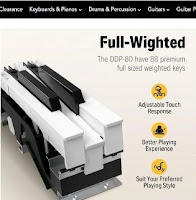

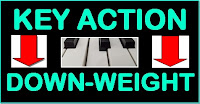


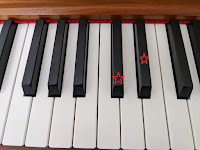
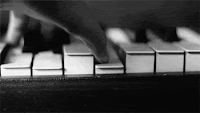


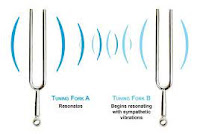
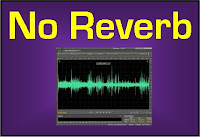

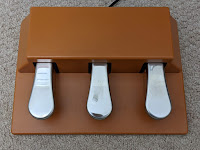





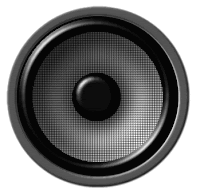

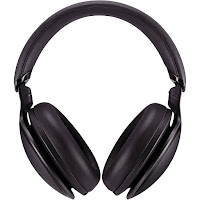


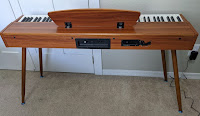








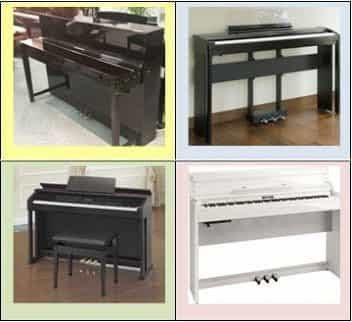


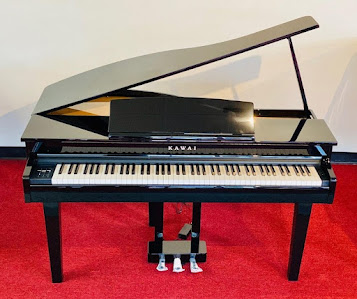

Thanks fotr this review.
Merci beaucoup pour cet avis très précis, détaillé et objectif !
Excellent review.
I am still researching digital pianos, and woukd be more likely to buy Kawai or Yamaha, despite the higher price. Especially if the piano ever needs servicing.
one of the youtube videos released sep2021 showing C1 stuck, and C3 did not bounce back fast enough, not sure if this is noticed on yours?
Thank you for this honest review. Donner is on to something, many of us just want one really good piano sample, with a great feeling keyboard. Maybe they'll get there.
I appreciate the thorough manner in which you reviewed the Donner. Thank you.
Maybe I missed it in the review but is this keyboard roadable? Can it be connected to an outside amplification source?
VERY GOOD REVIEW !!! I am buying the Donner now … and will let you know my impressions … I was in doubt between it and the YAMAHA P45 and the ROLAND FP10 …